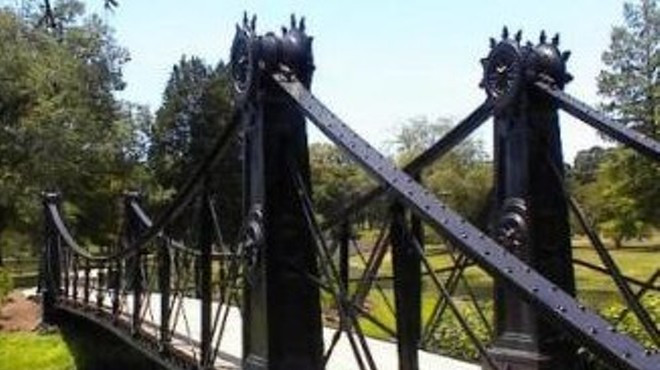It's clear why David Backes is the captain of the St. Louis Blues. Dude's always there, ready to perform. Last season he suited up for all 82 regular-season games — just as he did the season before. Last season he also scored the most goals for the club (24) and tied T.J. Oshie for the most points (54). But Backes is best because of his ass-kicking style of play. In addition to leading the team offensively, he also racked up the team's third-highest penalty minutes — 101. He shoots, he scores, he throws a punch!
Jon Jay is the Jennifer Lopez of St. Louis sports, at least in one very important way. You look at the rest of him, and he's an OK looking cat. Not bad, not drop-dead handsome. An average-ish sort of guy. But there's one part of Jon Jay that's nowhere near average. The man has a trunk so superbly stuffed, so completely crammed with junk that we can't even figure out how he found baseball pants to fit it right. Mos Def said it best: "Ass so fat that you could see it from the front." Oh, how right Mr. Def was. Jay may be best known for his bat waggle at the plate, but it's another waggle entirely that tends to grab our attention. Now, if he would only take our advice and change his walkup music to a little Sir Mix-a-Lot.
Go back to this time a year ago, and Kwamain Mitchell was in a much different place. He had been suspended from the Saint Louis University men's basketball team for the 2010-2011 season following allegations of sexual assault and was just trying to get his life back on track. The early fall of 2011 was not a great time to be Kwamain Mitchell. Too many questions, too many shadows. Just too too much. Then came March. More specifically, March 16, 2012, the night Kwamain Mitchell put the Billikens on his back and carried them past the Memphis Tigers, a team favored to easily defeat SLU in the opening round of the NCAA Tournament. Mitchell made sure that didn't happen, scoring 22 points, including two huge three-pointers down the stretch to help put the Tigers away, leading the Billikens to a 61-54 victory. Unfortunately for the Billikens, their run was cut short when they ran up against top-seeded Michigan State, but SLU pushed Tom Izzo's team to the brink also, thanks in no small part to Mitchell's contributions. The tournament performance was a perfect cap for a remarkable season, a season that saw Mitchell return to the team and fight to reestablish himself. The fact he was able to succeed was a testament to his toughness, as well as his skills. Life is a series of second chances; none of us ever get everything right the first time. Kwamain Mitchell made the most of his second chance. In doing so, he gave Billiken fans some great memories.
It isn't often you see an athlete capable of doing virtually anything on the field, but that's exactly what Mikala McGhee did again this past year at Pattonville High School. In softball, McGhee led the team with a .444 batting average, earning her first-team all-Suburban North Conference honors for the fourth straight year. On the hardwood, the 5-foot-11 senior had the highest scoring average (20.7 points per game) of any large-school player in the region, earning her first-team, all-state honors. Meanwhile, on the soccer pitch, she was one of Pattonville's leading scorers. She can hit, she can run, she can throw, she can kick, she can shoot, she can jump...any other athletic activities we forgot? If there are, chances are Mikala McGhee is probably good at them. In fact, she's probably great at 'em. Her future is on the hardwood, however: She's playing for Missouri State this year. But it's always nice to have fallback options, and if there's one thing a three-sport superstar has, it's options.
Stephon Young's name is already well known to local boxing enthusiasts. To the rest of the general population, not so much. There's reason to believe all that may change in the relatively near future, though. After years of having "celebrated amateur" permanently affixed to his name, Young turned pro in August of 2011. Less than a month earlier he had narrowly missed out on a spot in the Olympics, boxing for Team USA. Young has fought four times since his professional debut at the Ameristar in St. Charles, winning three bouts and pulling a draw in his last fight — his first professional bout on the road. He's currently the eleventh-ranked bantamweight fighter in the U.S., and his lightning-fast hands have drawn some (mildly hyperbolic) comparisons to a young Floyd Mayweather. In short, Stephon Young has plenty of talent, more than enough to deserve his standing as an exciting up-and-coming fighter here in the Midwest. Whether he goes the way of Dangerous Dannie Williams and Devon Alexander to become the "Next Big Thing" to hit the fight scene out of St. Louis remains to be seen, but all the ingredients are there.
While trekking through the varying topography of the Weldon Spring Conservation Area (off Highway 94 along the north bank of the Missouri River, it's easy to forget that this tract of forests, grasslands and bluffs was once dedicated to destruction: During World War II an army contractor made TNT here. Then in the 1950s and '60s, the Atomic Energy Commission processed uranium ore for nuclear bombs here. The state bought the land in 1978 and the feds cleaned out all the toxic stuff, leaving the department of conservation today with a safe — and breathtaking — 7,390 acres. The hiking and mountain-biking trails offer only one excuse for exploring the hills and ridges, plumed with oak, hickory and sycamore. Feel free to forage mushrooms, berries and greens while you're there. Hunters can bag rabbits, doves, squirrel and raccoons (plus deer and turkey on special managed hunts). The limestone bluffs afford panoramas of the wide Missouri, but if heights aren't your thing, you can pedal along the Katy Trail, which passes below. When Lewis and Clark came through here, there were no picnic tables, restrooms, ball fields or amenities. That holds true today, so you get to enjoy this area as they did — in the raw.
In Wildwood Highway T drops off Manchester Road and heads west into serious hill country. Rev up your steel horse and buckle down. Although the pavement along this stretch is smooth, the grades are steep and the curves tight — perfect for an adrenaline rush and the picturesque views. Turning northwest onto Highway 100, you get a break from the hills as you zoom into Washington on a flat four-laner. Heading north on Highway 47 through town, you traverse an old metal bridge and cross the Missouri River. Soybean and cornfields now greet your arrival into a low river valley and our state's prime grape-growing country. A right turn onto Highway 94 will take you on a winding path past several wineries and old Augusta. Don't let the scenic vistas distract you — this road is pocked with holes. By the time you reach Defiance, you've earned the right to sip on a beer (or two) at the biker-friendly bars. How you get home afterward is your business.
When you're lost and running late, the city's grid of streets provides order. But if you want to just stroll — that is, walk off a hearty dinner, reflect, relax — then repair to the curvaceous and leafy roads of Compton Heights, an elegant old subdivision nestled under the juncture of Grand Boulevard and I-44. The neighborhood's two main streets, Longfellow and Hawthorne boulevards, are named after literary giants. They were laid out in the late 1800s by the Prussian-born planner Julius Pitzman, who viewed "nature as neighbor, not as an enemy to be subjugated by some rectilinear grid." Under giant oaks you can gape at the heavy brick and stone mansions here, many built around the time of the 1904 World's Fair by wealthy German businessmen (the cone-roofed turrets display the castle style they preferred). Don't leave without visiting Compton Hill Reservoir Park. Its majestic 179-foot tower, built in 1898, used to be popular with citizens wanting a good view of downtown. Even today you can climb up and walk around the walls of the former reservoir and catch a glimpse of the city skyline.
Whether it's during the hectic, weekday lunch hour or a leisurely Saturday afternoon, Citygarden offers the perfect spot for spreading out a blanket and dining alfresco. Adults will enjoy watching the tourists, office workers and families that populate this 2.9-acre urban oasis in the center of downtown. Kids (and kids at heart) will scream in joy while playing in Citygarden's fountains and climbing about its two-dozen sculptures. And if you're wanting an impromptu sort of picnic (you forgot to pack the brie and crackers?!), Citygarden has its own restaurant — Joe's Chili Bowl at the Terrace View — that offers great sandwiches, salads and — you guessed it — chili. Save room for a treat at the Fire & Ice Cream Truck that pretty much parks it permanently at the center of Citygarden. One thing your basket should not contain, however, is alcohol. It's prohibited at Citygarden. But not to worry, there's enough fun to be had without drinking.
Hard to believe that when Henry Shaw donated the 277 acres that is now Tower Grove Park to St. Louis, the land was mostly treeless prairie. Shaw himself set about planting thousands of trees in the park and several of them still stand amid the thousands (7,500 at last count) that have sprouted up in the ensuing 150 years. Those trees provide the perfect canopy for joggers. Even if it's mid-afternoon on a 108-degree July day, there's always broad expanses of cool shade to be found along the paths and sidewalks of Tower Grove Park. And while we're pretty sure that Mr. Shaw wasn't a jogger (back in the 1860s people ran only when chased), he no doubt would be pleased by the legion of runners that can be found today trotting about his donated property. After all, one of the objectives of a good city park, according to Shaw, was to be "conducive to the health and happiness of its inhabitants."










